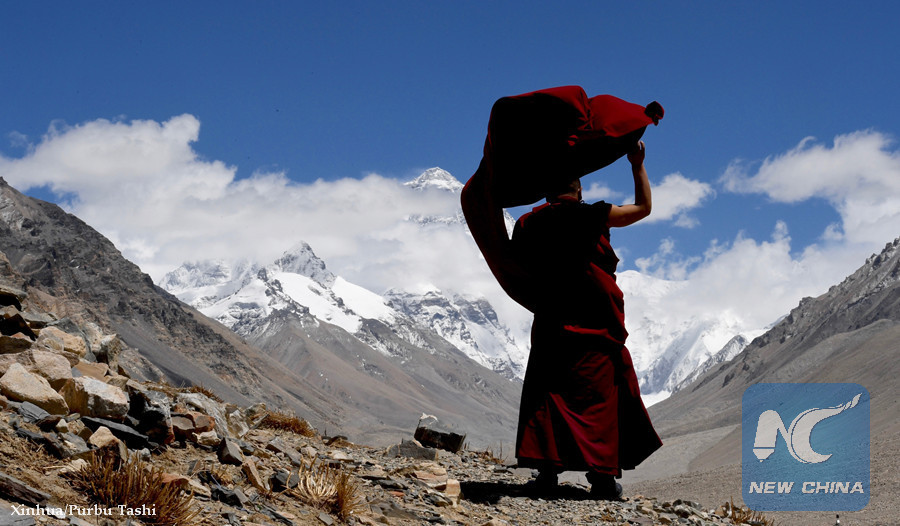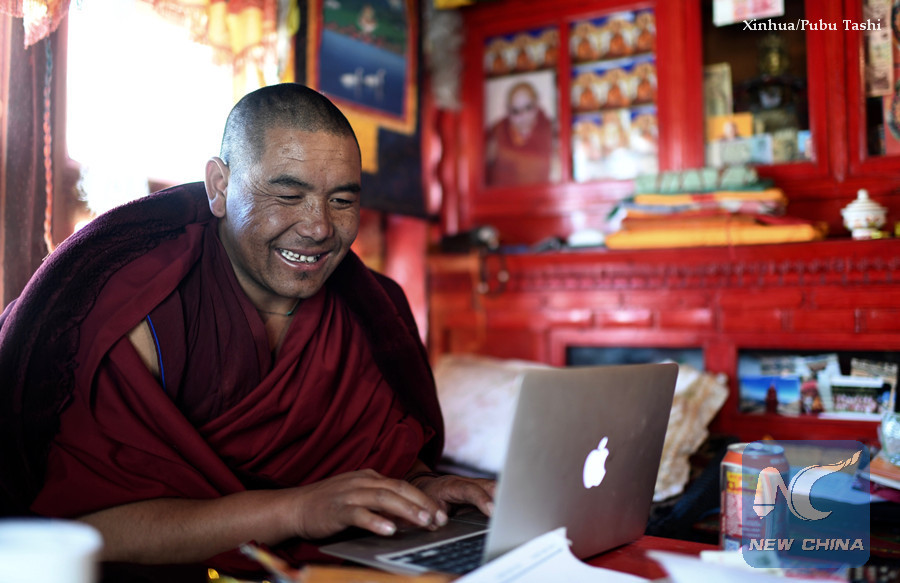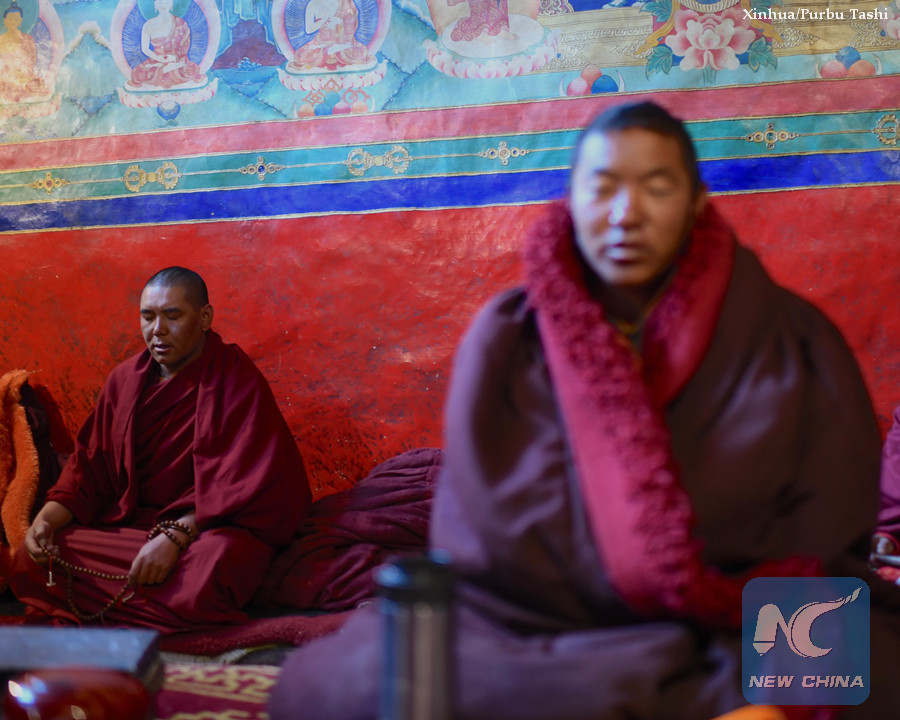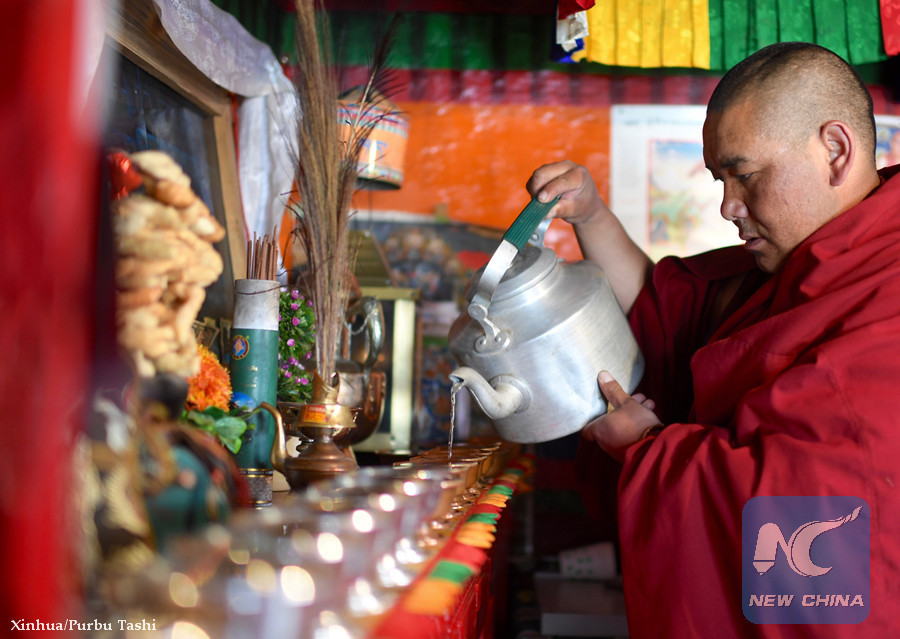
Lama Ngawang Peljor looks at Mount Qomolangma at the Rongpo Monastery in southwest China's Tibet Autonomous Region. (Xinhua/Purbu Tashi)
As the first ray of sunshine reaches the tip of a stupa outside the Rongpo Monastery, Ngawang Paljor braces against the wind and begins his walk along a winding path, chanting mantras as he goes.
Out of breath, he places his palms together and looks toward the snow-capped Mount Qomolangma, the world's highest peak, and enters the main hall of the monastery, 5,150 meters above sea level in Tingri County in Tibet.
And so begins another day for the 36-year-old monk at the world's highest Tibetan Buddhist temple.

Lama Ngawang Peljor lights a butter lamp. (Xinhua/Purbu Tashi)
Ngawang Paljor rises at 8:30 a.m., has a light breakfast and chants sutra in the main hall until noon. After lunch, he rests in the dormitory. It is summer, but a heater is still needed at such a high altitude. Modern technology, even something as simple as an electric heater, is still seen as novelty in the monastery.
After a postprandial snooze, the monk resumes his chanting in the main hall until 4 p.m.. The Rongpo Monastery is currently home to 13 monks and 14 nuns. Meals are simple and vegetarian. Supper consists of rice, green vegetables and fried wood ear mushrooms.

Lama Ngawang Peljor practices typing. (Xinhua/Purbu Tashi)
MODERN BLESSINGS
While his life seems a world away from China's megacities, a MacBook and smartphone reveal that monastic life is not totally divorced from modernity. At night, his studies complete, he practices typing in Tibetan script on his laptop and chats to friends all over China via the instant messaging app WeChat.
Each monk or nun at the monastery gets a monthly stipend ranging from 2,000 to 3,000 yuan (about 300 - 450 U.S. dollars). While Ngawang Paljor cares more about inner peace and the opportunity to read and understand the unique scriptures of monastery, his smartphone is also a most welcome blessing.
"Devoted to the study of Tibetan Buddhism, the most important thing in our lives, we must also take on chores as necessary such as fetching water and cleaning," says Ngawang Paljor.
The next day, he is tasked with something unrelated to Buddhist study -- the abbot has asked him to build a fence around the field in front of the temple to prevent livestock belonging to local herdsmen from trampling the grass.

Lama Ngawang Peljor builds a fence in ordinary clothes. (Xinhua/Purbu Tashi)
He removes his crimson robe and puts on the ordinary clothes of any worker. Woolly hat protecting his shaven head, only the red down jacket that protects him from the relentless wind distinguishes him as a monk.
In a tent beside the field, Ngawang Dorje, 38, sells souvenirs to tourists. He came to the Rongpo Monastery 15 years ago, the same year as Ngawang Paljor.
Ngawang Dorje chose not to become a monk. It is a lifestyle suited only to a very few. He makes his living by carving and selling "mani stones." These are just ordinary pieces of local stone carved with the six symbols of the mantra, "Om mani padme hum." The carving on the stones is seen as a highly devotional act, similar in nature to more recognizably doctrinal activities within the walls of the monastery.

Lama Ngawang Peljor (L) meditates. (Xinhua/Purbu Tashi)
CALL OF THE SOUL
Although Tenzing Norgay and Sir Edmund Hillary became the first men to reach the summit of Mount Qomolangma only 64 years ago, Tibetan monks have been striving to reach the peak of enlightenment for over 1,000 years.
Located on the north slope of the mountain, near the current base camp where aspiring climbers prepare for their ascent, Rongpo dates back only 100 years. "But the area has witnessed the spread of Buddhism in Tibet for many centuries," says Ngawang Paljor.
He mentions a local legend often told to tourists that the monastery was a place of retreat for Padmasambhava, also known as Guru Rinpoche, an eighth-century Indian Buddhist master. He heard the story countless times from his grandmother when he was a young boy, and it sparked his interest in Buddhism.
"At Tibetan Buddhist festivals or other important occasions, my grandma would fill a bowl with water before the Buddha shrine and pray for world peace and the health of our livestock," he recalls.

Lama Ngawang Peljor plays with a goat at the Rongpo Monastery. (Xinhua/Purbu Tashi)
Ngawang Paljor comes from a small village around 20 kilometers from the monastery. His father died young, and as the youngest boy in the family, he was his mother's favorite and was never asked to do manual work. He still remembers the day when he held his mother's hand and looked up at Mount Qomolangma, telling her that he wanted to become a monk.
"She was not surprised. She told me it was a very noble calling."
When he arrived at the monastery for the first time at age 21, he says it felt familiar. "Life inside the monastery was exactly as I had imagined," he says.
Although Ngawang Paljor was much older than many of his peers when he became a monk, the abbot appointed Ngawang Odser, a much respected monk and leader of the chanting of Buddhist scripture, to oversee his training.

Lama Ngawang Peljor pours water into cups in front of a niche in his dormitory. (Xinhua/Purbu Tashi)
STAY IN TOUCH
Devoting your life to the study of Tibetan Buddhism does not mean you must isolate yourself from what is happening outside the monastery. Ngawang Paljor reunites with his family twice each year.
In the fourth month of the Tibetan year, they celebrate Saga Dawa, the anniversary of Buddha's birth, enlightenment and death. Ngawang Paljor is excited because his brother's family will come to visit him.
In the tenth month of the Tibetan year, he returns to the family home for a month.
"In addition to spending time with my family, I chant scriptures and pray in the homes of other villagers," he says.
Now that an asphalt road connects Rongpo with the outside world, young monks like Ngawang Paljor have the opportunity to travel and see more of the world beyond the mountainous horizon.

The Rongpo Monastery near Mount Qomolangma. (Xinhua/purum Tashi)
Two calligraphy brushes lie beside his ink pot, gifts from a friend he met in Shanghai.
"When my friends from other parts of China travel to Mount Qomolangma, they come to see me at the monastery," he says.
In 2014, along with other monks, the monastery sent him to Lhasa, the capital of Tibet Autonomous Region, to study at the Buddhism Institute of Tibet. The institute does not confine its curriculum to scripture, but offers courses in subjects such as law, economics, culture and computer studies -- things a young monk cannot learn in a traditional monastery.
"I learned a lot and my horizons have been broadened. But I still have a long way to go to obtain the highest degree of the Nyingma sect," he admits.
When he graduated from the institute in 2016, he returned to Rongpo.
"Buddhism is extensive and profound. I must move forward one small step at a time," he says.

